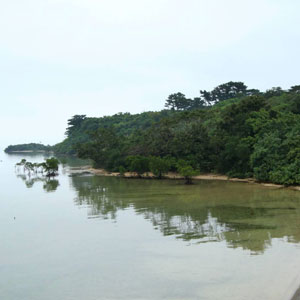Magazine | Voyages
Voyage ornithologique dans les îles japonaises d’Iriomote, d’Ishigaki et d’Okinawa (archipel des Ryukyu) du 15 au 21 mars 2017

Paysage le long de la route côtière du nord, île d’Iriomote, archipel des RyuKyu (Japon), mars 2017.
Photographie : Gareth Knass
Introduction
Le Japon s’étend sur près de 3 300 kilomètres de long, de l’île d’Hokkaïdo au nord, proche de la Sibérie orientale, à l’hiver froid et neigeux en hiver et frais en été, aux îles Ryūkyū (ou Ryukyu) au sud, proches de Taïwan, au climat subtropical humide. Les Ryūkyū sont composées des archipels d’Okinawa, de Kerama, de Daito, de Miyako et de Yaeyama. Du fait de leur isolement, elles possèdent une flore et une faune au fort taux d’endémisme : on peut donc y observer des espèces uniques au monde, comme le Pic d’Okinawa (Sapheopipo noguchii), le Râle d’Okinawa (Hypotaenidia okinawae), la Mésange d’Iriomote (Sittiparus olivaceus), le Serpentaire des Ryukyu (Spilornis perplexus), le Minivet des Ryukyu (Pericrocotus tegimae) ou le Chat d’Iriomote (Prionailurus iriomotensis). Plusieurs sous-espèces endémiques ont par ailleurs récemment été élevées au rang d’espèces distinctes, comme le Gobemouche d’Owston (Ficedula owstoni) ou le Colombar des Ryukyu (Treron permagnus). Ces îles constituent donc une destination intéressante encore méconnue des observateurs européens.
Gareth Knass et Shaun Coyle ont visité du 15 au 21/03/2017 trois des plus grandes îles de l’archipel des Ryūkyū : Iriomote, Ishigaki et Okinawa. Ils ont pu observer la plupart des oiseaux endémiques, ainsi que le mystérieux Chat d’Iriomote. Nous vous proposons une version française de leur rapport de voyage.
Abstract
Japan extends over nearly 3,300 kilometers long, from Hokkaido in the North, close to the Eastern Siberia, with a cold and snowy winter and a cool summer, to the Ryukyu Islands in the South, close to Taiwan, with an humid subtropical climate. The Ryukyu islands are composed of the Okinawa, Kerama, Daito, Miyako and Yaeyama archipelagos. Because of their isolation, their flora and fauna have a high rate of endemism: one can find them unique species such as the Pryer’s Woodpecker (Sapheopipo noguchii), the Okinawa Rail (Hypotaenidia okinawae), the Iriomote Tit (Sittiparus olivaceus), the Ryukyu Serpent Eagle (Spilornis perplexus), the Ryukyu Minivet (Pericrocotus tegimae) or the Iriomote Wildcat (Prionailurus iriomotensis), and several endemic subspecies have recently been raised to the rank of distinct species, such as the Owston’s Flycatcher (Ficedula owstoni) or the Ryukyu Green-pigeon (Treron permagnus). They therefore constitute an interesting and still unknown destination among European birders.
Gareth Knass and Shaun Coyle visited three of the largest islands of the Ryukyu archipelago: Iriomote, Ishigaki and Okinawa from the 15th to the 21th of March 1017. They found most of the endemic birds species as well as the mysterious Iriomote WildCat. We propose you a French version of their detailed and illustrated travel report.
Poursuivez la lecture de cet article, en vous abonnant dès maintenant !
Découvrez les Archives d’Ornithomedia.com
Pour seulement 10,00 €TTC/an (ou 6,00 € les 6 mois)
Profitez de plusieurs centaines d’articles en accès illimité et sans aucun engagement.
Compléments
Contact
Gareth Knass : garethknass@btinternet.com
À lire aussi sur Ornithomedia.com
Observer les oiseaux sur l’île d’Hokkaïdo en hiver
Ouvrages recommandés
- Birds of East Asia (Helm Field Guides) de Mark Brazil (janvier 2009)
- Endemic Birds of Japan de Frederic P. Miller, Agnes F. Vandome et John McBrewster (2010)
- Japan North & Hokkaido Travel Map (1 : 850 000) (janvier 2011)
- Photographic Guide to the Birds of Japan and North-East Asia de Tadao Shimba (Broché – 1 février 2008)
Source
Gareth Knass et Shaun Coyle (2017). Ryukyu Islands – Mars 2017. Cloudbirders. www.cloudbirders.com/tripreport/repository/KNASS_Ryukyu_03_2017.pdf




Aucun commentaire sur ce sujet
Participer à la discussion !